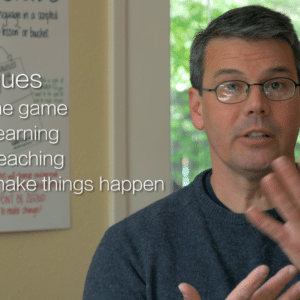
Each day is really skilled at "starting at the beginning" (image by James Jordan via Flickr Creative Commons).
You’ve found a fluent fool, and you want to fluency hunt their ability. So you start at the beginning, and during your hunt, whenever you get lost or confused, you simply start over – at the beginning.
A journey of a thousand miles begins with a single step.
Where to begin? A key element of fluency hunting is choosing the current best place to start, choosing the best beginning. And you can constantly improve on this starting point, as you begin to have a deeper understanding of all the “prerequisites” for fluent ability in your target skill.
This “starting point” is often the obvious, organic place where you must begin. In Christopher Alexander’s Nature of Order books, he describes an array of natural processes (organic and inorganic) that are only possible because nature “starts at the beginning”, at every scale between the cosmic and atomic. An embryo begins with a fertilized egg, and a single cell. A spider begins with a single line of web between two anchor points. A solar system requires a central anchoring body, like a sun, around which to form.
Every point in a process has its own “beginning”. To fertilize an egg you require mature adults, a spider web requires first a spider and a suitable habitat.
In language acquisition, in the process of practicing fluent speech, the starting point is that most common child’s question, “what is that?”.
But of course before you can ask “what is that?”, you must first find a “fluent fool” whom you will hunt.
There too, is an element of “beginner’s mind” that fluency hunting requires, much like the Zen attitude called “shoshin”, a state of openness, eagerness, and lack of preconceptions in the face of what you’re hunting, even at an advanced level. All of the WAYK family of techniques are designed to support and cultivate this attitude.
When fluency hunting a target skill, you are always searching for the best “beginning” possible. For example, in old-time fiddle playing, you want to start with bow rhythm before melody. In parkour (street gymnastics, like skateboarding-without-the-skateboard), you’ll discover quickly that to advance you need to already be skilled at soft landings and safety rolls.
A great question to ask your “fluent fool”, to find the starting point, and the general order/flow of proficiency, is “have you ever had a time when learning this skill, when you had to start over, and relearn a piece of this skill all over again, because you found you skipped an element that you needed in order to keep progressing?”.
Sometimes two elements of a skill work in parallel, and neither one truly comes first. Nevertheless, this question is always on the mind of a fluency hunter, they are always experimenting with the best beginning, and the best order of progression.
Introducing the technique in language acquisition
Short: “The first thing we do is technique: start at the beginning, in ASL hand-sign, ‘start [at the] start’. And the start is always ‘what is that?’.
Long: “Whenever we get lost, or return from some conversational tangent back to the game, we will always start over, at the beginning, with ‘what is that?’.”
Applying the technique in language acquistion
This is one technique you’ll return to over and over (as you may have guessed). It’s important to really drill this, and in the beginning, to not skip right into full fluent conversation. Give everyone a chance to find their footing again by always “starting at the beginning”.
- Start play with “what is that?”, after introducing a couple of primary techniques, like TQ Copycat and TQ Full.
- Anytime you feel lost as a game leader, “start at the beginning” with the object that is right in front of you (“your” object), with “what is that?”
- Over time you’ll get a sense for when you can skip starting with “what is that?”, but this will take a lot of play.
- TQ Newbie in the Lunatic Fringe is the ideal “beginning” for a new player, or a struggling player who needs to warm up a lot before games, where they can simply watch and copycat with no pressure. You may not always have enough players for this, but do it when you can.
But what about…?
Players at first may be reluctant to truly “start at the beginning” and “start over” when you feel the game calls for it. They’ll get used to it as you keep calling up this “rule of the game”, and then they’ll begin to rely on it as the game speeds up faster and faster.
The beginning of the game is also the most delicate time, when the game rules need to really be constantly called up and modeled.
- TQ Technique! means these are the “rules of the game”, and it’s just how the game works. In order to play, we play by the rules.





Great and usefull information.
We are starting to play with WAYK in Québec…
we do not have much support but that is not stopping us with the vision.
All the support we have is you.
Can’t wait to see the top 20 TC !!!
I realy think your are changing the civilised world in a very powerfull way.
As a matter of fact, I would put you at the top of the list !!
claude
Thanks for your support Claude – we’ll keep the techniques coming!
yrs,
Willem